Picking up where we left off, Orion's Sword appears as a compact asterism of three closely spaced, apparently inseparable stars hanging south of the Great Hunter's Belt. When the night is crystal clear, free from all sources of pollution, particularly light pollution, the middle star in Orion's idle Sword surrounds itself with diffuse nebulosity. Although nebulae are hard to see with the naked unaided eye, the ''middle star'' beat the odds. Even under moderate light pollution, with the diffuse illumination losing its path in a veil of artificial lights, a keen observer will still be able to appreciate a flickering blip desperately trying to pique his/her retinal sensors after journeying for 1,300 years. When the same observer happens to stick their eyes into the eyepiece of a moderately sized telescope, he/she is led into a world unto itself. The faint flickering blip, the small patch of diffuse nebulosity suddenly grows into a colossal stellar nursery similar in character to the Flame or the Horsehead Nebula, designated as M42 or commonly known as the Orion Nebula, the Great Orion Nebula or NGC 1976.
The following photograph shows how the compact asterism of Orion's Sword blows up, extending for tens to hundreds of light years. Two of the three stars are nebular regions, while the southernmost member reveals a cluster of blue-white stars. Though the nebulae and the star cluster may seem like distinct entities in this image, they represent a single structure known as the Orion A Molecular Cloud. The gap appears due to thick clouds of interstellar gas blocking the free passage of visible radiations coming out from stars that lie behind. With bigger telescopes, precise engineering, and playing some tricks, astronomers can see stars forming, planetary systems accreting from circumstellar discs, and of many such things, witness real-time stellar winds carving out the landscape of dense interstellar gas.
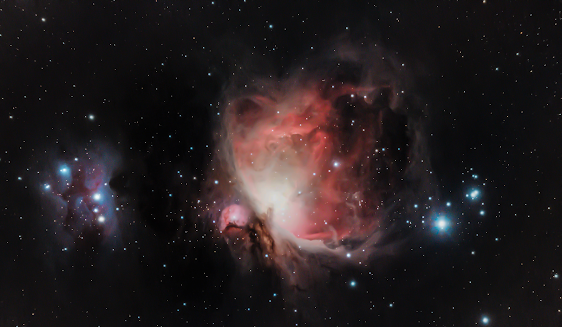 |
Long exposure of the sword using LRGB filters.
Image Credits: Public Domain (source link), via Wikimedia Commons.
|
Cut off by the aforementioned dark distribution of gas, north of M42 lies a beautiful specimen of an emission nebula and an H II ionisation region designated as Sh2-279 or S279 or Sharpless 279. The Sharpless Catalogue, much like the Messier Catalogue or the New General Catalogue, is a classification scheme for H II regions, first published by American astronomer Stewart Sharpless. Since astronomical labelling can be unappealing to people alien to the trade, Sh2-279 goes by another name - the Running Man Nebula. The tip of the sword is marked by Iota (ɩ) Orionis, popularised as Hatsya.
 |
A star chart of the Orion constellation showing in detail the distribution of the interstellar gas,
NGC objects, nebulae and star clusters, H II regions, variable stars, Messier objects, and other stuff around the Sword.
Image Credits: Public Domain (source link), via Wikimedia Commons.
|
The Running Man Nebula gets its unusual nickname because the outline of the central red-pinkish region of nebulosity (in the long-exposure picture shared prior in this article and the image below) resembles a cosmic man running across the depths of interstellar space. If I were to share my opinion, I would say the Running Man looks more like an X-man, and I mean literally. Catalogued as Sh2-279, the Running Man Nebula encompasses three more nebulae, made distinct by walls of dark nebular matter rising against the background of ionised gas. Collectively known as the NGC 1970s, the three reflection nebulae, NGC 1977, NGC 1975, and NGC 1973, were all independently discovered by astronomers across different time periods. The outline of the X or the running man, as everyone knows, appears only in long-exposure photographs and is not so easy to see through a small telescope or a binocular.
 |
The Running Man Nebula or collectively, the NGC 1970s.
Image Credits: Public Domain (source link), via Wikimedia Commons.
|
Sh2-279 outlines the core of the Running Man Nebula. The characteristic red-to-pinkish glow materialises due to the ionisation of hydrogen happening from the intense radiations spit out by 42 Orionis - the central star in NGC 1977. 42 Orionis, the very bright star closest to the dark column of gas and dust rising upwards from the bottom, is a double star with a 12 solar-mass massive B-type blue-white primary. The overall purplish-blue tinge comes from visible light scattering off of gas molecules. NGC 1977 fills the entire field of view from left to right immediately below the X-outline. NGC 1973 is a cloud of gas enveloping the small star cluster looking to the upper-left of the field. NGC 1975, while separate from 1973, proudly occupies the upper-right half of the exposure.
NGC 1981, photographed below, is a loose clustering of stars, gravitationally bound though, situated further north of the running man.
.jpg) |
NGC 1981 cluster north of the running man nebula.
Cropped from source.
Image Credits: Public Domain, via Wikimedia Commons.
|
When seen through an optical telescope, the Great Orion Nebula takes on a greenish tinge along with the familiar regions of red and blue-violet. The red luminance comes from the characteristic H⍺ emission at 656.3 nm. The blue-violet colouration comes from the intense visible and high-energetic radiations emanating from massive O-type stars. But the greenish tinge became a great mystery, almost as great as the nebula, for astronomers in the early 20th century found that no element in the periodic table produced a spectral signature similar to the elusive green glow in the Orion Nebula. Naturally, the temptation was to think of an entirely new element, supposedly synthesised only in nebulae. The hypothetical element was named Nebulium. However, Nature did not turn out to be kind enough to allow such an element to sit on the periodic table. Sometime later, a better understanding of atomic physics helped astronomers link nebulium to an extremely rare electron transition occurring in doubly ionised oxygen atoms.
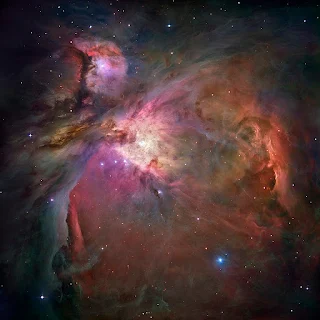 |
One of the most detailed photographs of the Orion Nebula taken by the HST.
Image Credits: Public Domain (source link), NASA, ESA, and STScI. |
Over an extended period between 2004 and 2005, Hubble took a series of photographs of the Orion Nebula across visible and infrared bands. This one-of-a-kind image offers us a glimpse into the turbulent heart of star formation. Giant filaments of gas extending for tens of light years can be seen flowing in and out, twisting and turning, branching off and twisting further. The Orion Nebula regularly spawns diverse classes of stars, from massive O- and B-type stars to tiny M-type dwarf stars, 3,000 of which appear in the said image. In various stages of their formation, young stars continue to carve out features into the clumped-up distribution of nebular gas. Strong stellar winds arising from young hot stars give rise to bow shocks and hydrodynamical instabilities such as the Kelvin - Helmholtz instability, i.e., non-linearities appear at the interface of two smoothly flowing fluid layers, which tend to play their fair share in forming new stars by developing inhomogeneities and collapsing volumes of gas into compact regions therefore, essentially seeding future star formation. One star leads to another, which in turn, leads to two more, and likewise, more and more stars keep forming inside stellar nebulae till it runs out of gas. A typical nebula can produce hundreds if not thousands of stars for a few million years before completely dispersing away. Some of the young stars forged in these nebulae become so massive that they die out within a blink of cosmic time. The Orion Nebula is estimated to be not more than 3 million years. As such, humanity, starting from our earliest distant ancestors, is much older than the Orion Nebula. Some of the young stars we can see in the nebula are not older than 10,000 years, born right at the beginning of the Holocene epoch on Earth.
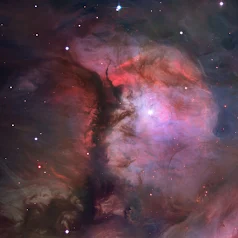 |
M43 emission nebula seen with its central
star and multidirectional gas flows.
Image Credits: Public Domain,
NASA, ESA, and STScI. |
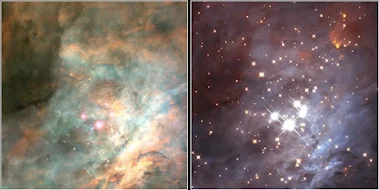 |
The Trapezium cluster in optical (left)
and infrared (right) light as imaged by the HST.
Image Credits: Public Domain, NASA.
|
M43 (NGC 1982) was first catalogued as a distinct nebula by the French astronomer Jean-Jacques d'Ortous de Mairan in 1731. With the invention of powerful telescopes, astronomers learned that M43 and M43 are all part of the same nebula, along with the Sh2-279, the NGC 1970s, falling under the distinct subgroup of OB1 c of the Orion Complex. Named in his honour, de Mairan's Nebula is visually separated from the Orion Nebula by a wall of dense gas and dust known as the M43 lane. M43 is illuminated by a massive B-type star designated as HD 37061 (Henry Draper Catalogue). HD 37061 is a triple star system with the brightest component being a spectroscopic binary. The primary candidate is almost 20 times more massive and 6 times larger than the Sun. Being a B-type star, it has a surface temperature close to 31,000 K and shines with the equivalent luminosity of 26,000 Suns. It also spins rapidly at 200km/s. The reddish-pink H II ionisation region enveloping the central star measures a diameter of 2.1 light years and shines with a luminosity (obviously excluding HD 37061) of 78 Suns.
The M42 owes its picturesque beauty to a very young cluster (< 5 million years old) in its core known as the Trapezium Cluster or the Trapezium Orion Cluster. As seen from the adjacent image, the Trapezium is named so because of the tight clustering of four very bright stars, labelled as A, B, C, and D, all under the umbrella designation of θ₁ Orionis. The brightest, θ₁ Orionis C, is a massive, 33(± 5) solar mass O-type blue main sequence star, almost 10 times larger than the Sun, 204,000 times more bright, and has a surface temperature exceeding 39,000 K. All of the four main Trapezium stars are themselves multiple star systems having three or more companions. The Trapezium cluster contains several stars, well in the range of a few thousand as per some estimates, including both massive and dwarf stars, circumstellar/protoplanetary discs or proplyds, and even a black hole!
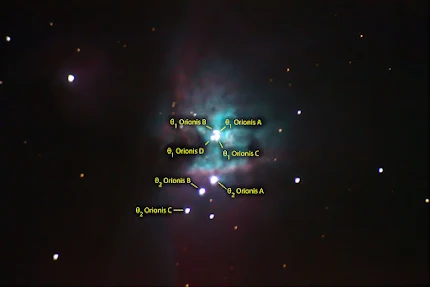 |
The Trapezium Cluster as seen along with surrounding luminosity which is
called the Huygens region.
Image Credits: Public Domain (link to source),
via Wikimedia Commons.
|
Iota (⍳) Orionis or Hatsya is the brightest star in Orion's Sword. Hanging below at the southernmost tip of the sword, ⍳ Orionis lies at an average distance of 1,340 light years from the Sun. It is frequently associated with the open star cluster NGC 1980, although probably, it may not actually be part of the 1980 cluster. Of all the stars in ⍳ Orionis, the one that stands out, being the most massive and invariably outshining its associates, is ⍳ Orionis A. ⍳ Ori A is again a triple star system, with Aa1 and Aa2 as spectroscopic binaries, where the third member, Ab lies far at 5,000 AU from the Aa binary pair. ⍳ Ori Aa1 is an O-type blue giant star 23 times heavier, almost 8 times larger, and 68,000 times more luminous than the Sun, having a surface temperature close to 32,500 K.
With this article, we are for now done with the Orion constellation. Of course, the nebulae out there will keep on producing new stars. Who knows, as you read this sentence, maybe, a new star is seeded deep inside M42's optically impassable walls of gas. If it is going to be a high-mass star, then almost a million year is going to pass before the star begins to shine across visible wavelengths and blast through the gaseous confinement, headed straight towards Earth, so that our future generations, could drink to the arrival of a new star. On a personal note, I want to be desperately optimistic that one day, in my lifetime or in those of my future generations, our night skies will change for the better. We will change for the better. What could possibly be more enticing than seeing a new star arrive in our night skies, not a supernova, but just a simple star, a star that will shine for a million years, bearing silent witness to our waxing and waning human lives?



.jpg)






Comments
Post a Comment